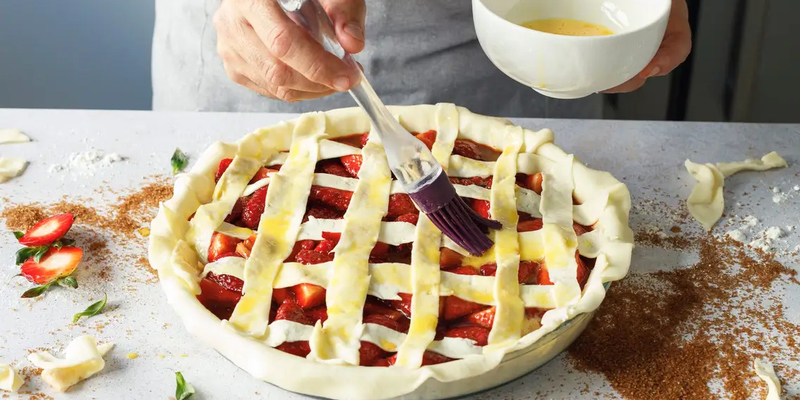4 Simple Tricks to Avoid Soggy Pie Crusts Every Time
Pie is a special dessert that everyone loves to eat on holidays. Making a pie can be a labor of love. But what if you make a pie with your hard work, and it turns out with a soggy crust? It's a huge disappointment.
Pie's flavors don't taste well, and the texture becomes mushy. This bad experience can make you give up on baking. But don't worry! It happens with everyone when they start baking.
Practice makes a man perfect, and some tips in addition make it excellent. You can make the pie as your cup of tea with our tricks.
This blog post'll discuss four methods for making a perfect pie and avoiding a soggy crust. The crust comes out crispy and golden every time you bake a pie.
Read more to make a big difference in your baking!
The Importance of a Crisp Pie Crust

A crispy pie crust is not only a beautiful layer that decorates the pie but is significant for making it amazing. If there is a well-done pie with a crispy crust, the combination of soft and hard textures intensifies the pleasure of eating it.
Think about it: A super crisp, amber-brown skin that adds a good and contrasting crunch to the soft and glutinous insides.
This is the sort of contrast which makes it such a pleasure to take a bite of pie." If not, your pie might be tasty, but it will not be the same, and nobody likes second best.
A crisp crust also helps give the pie shape and hold it together. It provides the filling with a firm base, making it easier to scoop and bite. Further, well-baked dough adds taste to the entire equation, increasing its compatibility with the filling.
4 Simple Tricks to Avoid Soggy Pie Crusts
Here are four easy techniques to ensure your pie crusts stay deliciously crisp:
1. Pre-Bake the Crust (Blind Baking)
Blind baking is a game-changer for crispy crusts. Start by lining your unbaked crust with parchment paper, then fill it with pie weights or dried beans. This keeps the crust from puffing up or shrinking.
Pop it in the oven until the edges turn golden. After that, remove the weights and parchment and give it a few more minutes to dry the bottom. This head start on baking means your crust will stay crisp even after you add the filling.
2. Use a Hot Baking Sheet
Here's a simple trick: heat a baking sheet in the oven while preheating. When it's time to bake, put your pie directly on this hot surface. The heat jump-starts the cooking process for the bottom crust.
This method is especially good for fruit pies, which tend to have juicy fillings. Quick heat helps seal the crust before it absorbs too much moisture.
Just be careful if you're using a glass pie dish; the sudden temperature change could cause it to crack.
3. Brush with Egg Wash

An egg wash is like a raincoat for your crust. Beat an egg with water, then brush this mixture over your crust before adding the filling. As it bakes, it forms a thin, protective layer.
This barrier helps keep the filling's moisture from seeping into the crust. It also gives your pie a beautiful golden sheen. This simple step makes a big difference in both looks and texture.
4. Adjust Your Filling
Sometimes, the secret to a crisp crust is in the filling itself. If your filling is too wet, it's more likely to make your crust soggy. For fruit pies, try cooking the filling before adding it to the crust.
You can also add a sprinkle of flour or cornstarch to absorb extra juice. Make sure your filling is nice and thick before pouring it in for cream pies. These small tweaks can help keep your crust crisp and your pie perfect.
Achieve Perfect Pie Crusts Every Time
Now you have learned these four simple tips, you will never have to endure a pasty, limp pie crust again. You know that you are getting closer to that perfect pie.
If you have not baked a cake before due to this delusion, you should disregard the fear of a soggy bottom. These methods, discussed in the article, can go a long way toward making a change you would not believe.
Remember, practice makes perfect. Despite it all, the crust of succeeding pies can only improve if you want to make that perfect crisp crust.
So get ready to roll up your sleeves and start mixing, get your rolling pin ready, and let the making begin. Happy baking!
Frequently Asked Questions
Q: What is blind baking?
Ans: Blind baking means cooking the pie crust before adding the filling. You line the crust with parchment and weights, then bake it. This helps the crust get crispy and prevents sogginess when you add wet fillings.
Q: Why use a hot baking sheet?
Ans: A hot baking sheet gives the bottom crust a quick blast of heat right from the start. This helps cook the crust faster, sealing it before the filling can make it soggy. It's especially good for juicy fruit pies.
Q: How does egg wash help?
Ans: An egg wash acts like a shield for your crust. Brushing it on before adding the filling creates a thin layer that helps keep moisture out. This means your crust stays crisp, not soggy.
Q: Can I use any filling with these methods?
Ans: These tricks can be used with most fillings, but some need extra care. Try cooking them a bit or adding a thickener for very wet fillings. This helps reduce excess moisture that could make your crust soggy.